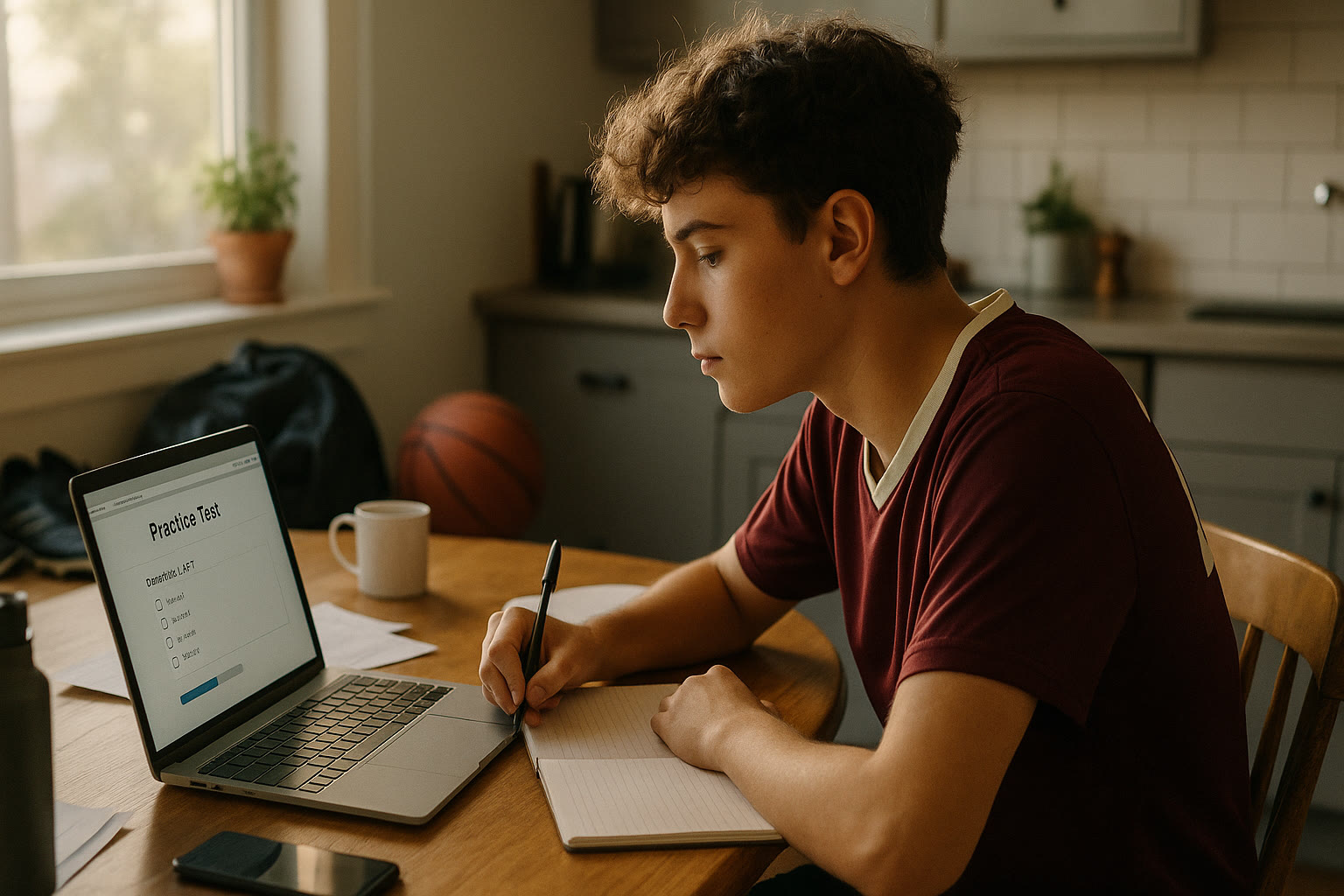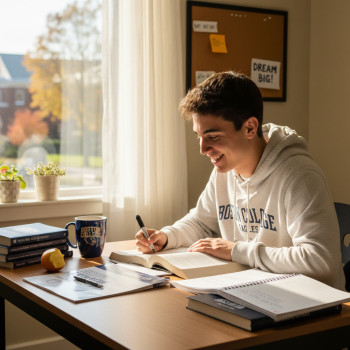Why this guide matters: the student athlete’s double play
If your teen spends afternoons on the field, evenings in the weight room, and weekends traveling for tournaments, you already know that being a student athlete is a full-time commitment. Add college applications and the Digital SAT into the mix and it can feel like juggling three schedules at once. This guide is written for parents who want to help their athlete prepare for the SAT without sacrificing training, team time, or sleep. You’ll find practical ways to fit effective SAT prep around practices and games, how to use personalized tutoring wisely, and tips to keep your child confident and balanced.

Understand the Digital SAT—what’s different and why it helps athletes
The College Board’s Digital SAT is shorter, adaptive, and delivered on a tablet or laptop. For busy athletes, that means a shorter time commitment on test day and faster score releases. It also includes tools—like a built-in calculator for some sections and zoom features—that can make focused practice more efficient. Knowing how the test is structured helps you plan study time in a way that doesn’t compete with practices or travel.
Quick essentials: structure and timing
- Two main sections: Reading & Writing and Math (adaptive across modules).
- Shorter overall testing time than the older paper SAT—less time locked into a testing center.
- Practice tests are available digitally, so your teen can simulate test conditions on a laptop at home between drills.
Start with a realistic timeline
Creating a timeline is the easiest way to keep SAT prep from colliding with sports commitments. The timeline should be personalized: depending on current skill level, college goals, and season schedules, preparation could be as short as 6–8 weeks of focused work or as long as 4–6 months of steady progress.
Two sample timelines
| Scenario | Timeframe | Focus |
|---|---|---|
| Off-season athlete with 8–12 hours/week free | 3–4 months | Comprehensive prep: diagnostic test, content review, weekly full-length digital practice tests |
| In-season athlete with limited time | 6–12 weeks (micro-sprints) | Targeted practice: focus on weakest question types, short daily drills, weekend practice test once every 2 weeks |
Why the timeline matters: a student athlete’s energy is not unlimited. Short, focused study blocks delivered across a realistic timeline often beat marathon weekend sessions that leave your teen exhausted and under-recovering for practice.
How to make practice time efficient (so it won’t cut into practice)
Quality beats quantity. Here are small, high-impact ways to study that respect an athlete’s schedule.
Micro-study sessions—20 to 40 minutes that count
- Warm-up drills: 10–15 minutes of focused problem-solving (e.g., five reading passages or 15 math questions) right after school before practice.
- Recovery review: 20 minutes in the evening reviewing mistakes from the day’s practice test when the brain consolidates learning.
- Travel time learning: bite-sized flashcards, vocabulary apps, or short video lessons during bus rides.
Weekly rhythm: keeping it consistent
- 2 short daily sessions (20–30 minutes) Monday–Friday.
- One longer session (60–90 minutes) on a less busy day—simulate full digital testing conditions occasionally.
- End each week with a short skills checklist: what improved, what needs more work.
Set goals that support both college and athletic ambitions
Goal-setting helps motivate students and keeps expectations realistic. Goals should be specific, measurable, and tied to both academic and athletic calendars.
Types of goals
- Score goals: a target score that aligns with the student’s list of colleges and scholarship criteria.
- Process goals: number of practice tests per month, consistent weekly study hours, or completion of a certain module of practice content.
- Balance goals: keep GPA and sport participation steady—e.g., maintain a 3.5 GPA while preparing for the SAT.
Personalized tutoring: when and why to consider it
Personalized tutoring can be a game-changer for student athletes because it targets gaps efficiently and respects limited availability. One-on-one guidance and tailored study plans allow tutors to design sessions around practice times and travel schedules.
What to look for in a tutoring program
- Flexible scheduling that aligns with practices and meets on weekends or evenings when needed.
- A focus on diagnostics and targeted improvement—not just more practice tests.
- Transparent progress tracking so you can see where gains are happening.
Example: Sparkl’s personalized tutoring blends expert tutors, tailored study plans, and AI-driven insights to pinpoint areas that will move the needle fastest for busy student athletes. That combination often allows athletes to make meaningful score improvements with fewer hours of prep compared to a generic plan.
Balancing physical training and mental energy
Training hard means mental fatigue is real. Sleep, nutrition, and recovery have a measurable effect on test performance—sometimes more than an extra hour of late-night studying.
Practical wellness rules for peak test-day performance
- Prioritize sleep: 8–9 hours is ideal for teenagers, especially the night before practice and test day.
- Fuel for focus: balanced meals with protein, healthy fats, and complex carbs to sustain concentration during study sessions and the test.
- Active recovery: light movement, stretching, or breathing exercises after study blocks to reset the brain.
Test-day logistics that parents should handle
Minimize stress by owning the checklist: registration confirmation, device and charger if allowed, permitted ID, comfortable clothes, a practiced route to the test center (or a quiet place with a reliable device for the digital test), and a game plan for the morning.
Checklist for test-day readiness
- Confirm registration and admission ticket ahead of time.
- Pack snacks for after the test and a water bottle (if allowed).
- Ensure the device and Bluebook or testing app are updated and practiced on at least once in the weeks before the test.
- Plan a calm morning: light exercise, a good breakfast, and an early arrival that allows time to settle in.

Accommodations and special considerations for athletes
Some student athletes may also need test accommodations—for example, because of a documented learning difference, injury, or medical condition. College Board requires approval for accommodations and recommends applying early. If your athlete has an injury during the season (like a concussion), reach out to school coordinators quickly to understand available options.
Timing and process
- Start the accommodations application as early as possible—approval can take weeks.
- Coordinate with school SSD coordinators or counselors to gather documentation and submit requests quickly.
- Know that some accommodations on the digital test are provided differently than on paper tests—ask what substitution (e.g., screen reader vs. human reader) might apply.
Practice tests: how often and how to use results
Practice tests are diagnostic tools, not just practice. For athletes, frequency should balance with season intensity. Aim for meaningful test exposures instead of simply increasing quantity.
Suggested cadence
- Baseline diagnostic: take one full-length digital practice test to identify strengths and weaknesses.
- In-season: one every 2–3 weeks if energy allows, focusing on specific question types between tests.
- Off-season: weekly or biweekly practice tests to build stamina and refine pacing.
Using results effectively
Don’t obsess over raw scores alone. Break down results into actionable areas: question types missed, timing issues, and careless errors. A tutor or an intelligent study platform can translate practice test data into a targeted plan—so study time fixes the right problems.
Time management strategies parents can coach
Your support in establishing routines is invaluable. Student athletes often respond well to structure—help them carve out predictable study windows and protect them like practice commitments.
Two practical routines
- Morning minutes: 20 minutes of light reading or vocabulary before school to warm up the brain without draining energy for practice.
- Post-practice review: a 25–35 minute session after practice to correct errors from practice problems when the brain is primed to consolidate learning.
Keeping motivation high—less stress, more momentum
Pressure can be particularly acute for student athletes juggling scholarships, team expectations, and family hopes. Celebrate small wins and emphasize progress over perfection. Remind your teen that admissions consider the whole person: athletics, academics, character, and trajectory.
Encouragement tactics that work
- Celebrate process milestones (first diagnostic, first weekly streak) rather than fixating only on scores.
- Use team goals: if teammates are also preparing, short group review sessions can be a social motivator.
- Protect rest: a well-rested athlete often outperforms an over-studied one.
How colleges view student athletes and SAT scores
Colleges evaluate student athletes holistically—SAT scores matter, but so do game film, coach recommendations, and academic readiness. A strong SAT score complements athletic achievements and can open scholarship opportunities and academic programs. For students aiming for NCAA Division I or II, be mindful of eligibility timelines and academic benchmarks.
Cost-effective prep options and where to invest
Not all prep investments are equal. Free resources and structured paid help both have roles to play. Free official practice materials are great for baseline prep; paid tutoring is worth considering when you need targeted, efficient progress.
Smart spending priorities
- Invest in a diagnostic test and targeted tutoring if the student needs to raise their score by a significant margin.
- Use free official practice materials and timed digital practice tests to supplement learning.
- Consider a short block of personalized tutoring (like focused weekly 1-on-1 sessions) rather than an open-ended long-term package—this often yields better ROI for busy athletes.
Putting it all together: a sample weekly plan for a varsity athlete
| Day | Study (20–40 min) | Longer Session (60–90 min) | Notes |
|---|---|---|---|
| Monday | Vocabulary + 10 math problems | — | Quick warm-up before practice |
| Tuesday | Reading passage + error review | 60-min session on weak math topic (off day) | Use targeted resources |
| Wednesday | Timed math drill | — | Short and focused |
| Thursday | Writing grammar mini-lessons | — | Hold energy for practice |
| Friday | Light review + flashcards | — | Recovery day |
| Saturday | — | Full-length digital practice test (alternate weekends) | Simulate test conditions |
| Sunday | Error analysis (30–40 min) | 60-min review with tutor or study partner | Plan the week ahead |
When to pause prep (and why it’s okay)
Injury recovery, playoff runs, and final exams are legitimate reasons to pause or scale back prep. The key is communication: if your teen needs to step back for a period, adjust the timeline and reschedule the test. A focused, refreshed student will always perform better than a burned-out one.
Final thoughts: be the coach off the field
Parents play a coaching role that matters. Not by micromanaging every practice question, but by creating a structure that respects your athlete’s dual commitments. Encourage consistent, efficient study; protect sleep and recovery; consider targeted tutoring when you need smarter—not harder—prep; and celebrate progress. The goal is to help your student present their best self to colleges: academically prepared, athletically committed, and emotionally resilient.
With thoughtful planning, the right supports, and a few small routines, your student can meet SAT goals without benching their sport. And when you need tailored help that fits a busy schedule, personalized tutoring—like Sparkl’s one-on-one guidance, tailored study plans, expert tutors, and AI-driven insights—can be an efficient way to make every study minute count.
Ready to take the next step?
Start with one diagnostic practice test, set a realistic timeline around your student’s season, and build a short weekly routine. When you add targeted support—whether that’s a flexible tutor or a focused study block—you’ll give your student the best chance to shine in both academics and athletics.














No Comments
Leave a comment Cancel